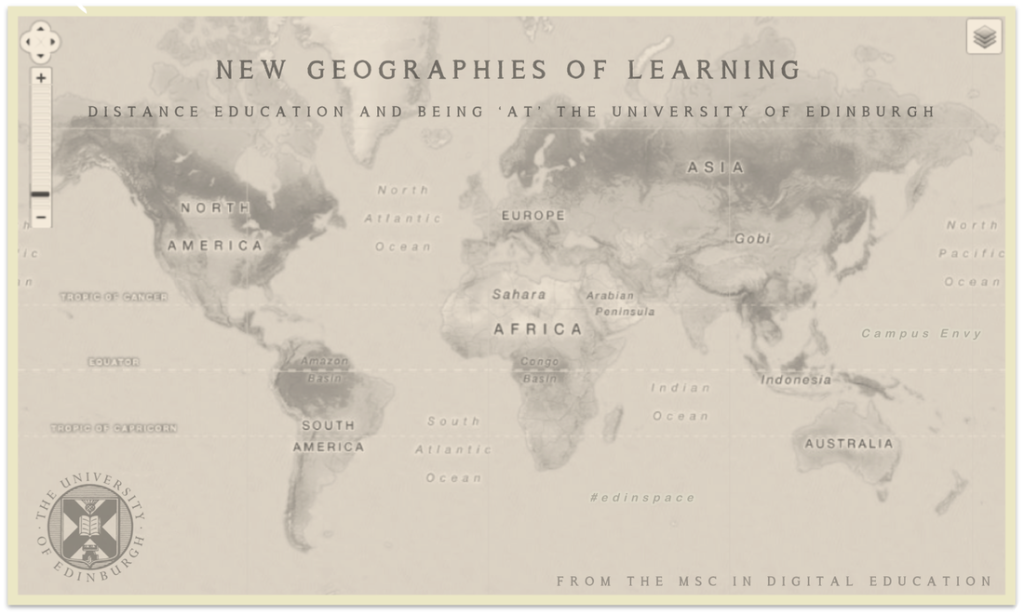A paper I co-authored with Dr. Sian Bayne at the University of Edinburgh and James Lamb, a colleague from the MSc in Digital Education programme at the University of Edinburgh has now been published in the journal Higher Education. The paper investigates the findings gathered from the recently completed project New Geographies of Learning: distance education and being ‘at’ The University of Edinburgh.
- Bayne, S.; Gallagher, M.S. & Lamb, J. (2013). Being ‘at’ university: the social topologies of distance students. Higher Education, 2013, DOI 10.1007/s10734-013-9662-4.
It is, at least I think, of great interest to those participating or developing elearning programmes, ones that place a special emphasis on community interaction and participation. I think the paper illustrates that while the comings and goings and levels of affinity that students exhibit in regards to online participation is a highly complex dynamic, it is not an entirely unpredictable one. It is also one that repositions and redefines geography as an agent in that process. For years, we have been quick to proclaim the death of geography in regards to online learning. This paper and this project demonstrates that it is far from dead; it just evolved along with everything else. For designers, teachers, or participants in elearning programmes, this is a good place to begin building (or understanding) the strength of community interaction online.
I am particular fond of the bits on Urry’s new mobilities paradigm and the four kinds of social space outlined by Moll and Law (particular the fluid and fire spaces, particularly apt for the perpetual shifts in strength of affinity and participation for elearners). Anyone familiar with these works knows they can be challenging (in the most positive way), but they really seem to work well in this context.
- Urry, J. (2007). Mobilities. Cambridge: Polity Press.
- Mol, A., & Law, J. (1994). Regions, networks and fluids: Anaemia and social topology. Social Studies of Science, 24(4), 641–671.
On a personal level, I think it reads like a dream and that is mostly Sian Bayne’s doing. She is a marvel at this in her capacity for tackling some fairly complex datasets and marrying them to an overriding logic or theory. A real professional and a real joy to work with; she was my supervisor during my time on the MSc programme and she continues to mentor me and I am forever grateful. James Lamb I consider a kindred spirit in multimodality and beyond, a colleague, and a friend. We have worked on projects before and I sincerely hope we keep working on projects in the future. It is one of the purest joys in my life, these types of intellectual exchanges and projects steeped in curiosity. And these are some of my favorite people to explore them with. So there you have it. The citation and link are below. The abstract is below that.
Citation & Abstract
Bayne, S.; Gallagher, M.S. & Lamb, J. (2013). Being ‘at’ university: the social topologies of distance students. Higher Education, 2013, DOI 10.1007/s10734-013-9662-4.
This paper considers how online, distance students enact the space of ‘the university’, in the context of the rise of distance education within a traditional, ‘elite’ institution. Aiming to provide insight into how students translate into distance the space of a university which has traditionally had its basis in conventional on-campus education, it locates itself within the ‘new mobilities’ paradigm (Urry in Mobilities. Polity Press, Cambridge, 2007), drawing on four different kinds of social space delineated by Mol and Law (Soc Stud Sci 24(4):641–741, 1994) and Law and Mol (Environ Plan D 19:609–621, 2001) in order to analyse narrative and visual data generated with distance students at the University of Edinburgh. The paper shows that the material campus continues to be symbolically and materially significant for a group of students who may never physically attend that campus. Distance students, we find, need their own version of the ‘spatial certainties’ of bounded, campus space. Yet, in exploring the ‘new proximities’ of online distance education, we also argue that to define institutional and academic authenticity solely in terms of this bounded, ‘regional’ space is inadequate in the face of the other topologies which also come into play throughout distance students’ accounts of what it means to be ‘at’ university.


this is great, and very timely for me as nearly finished with developing my proposal for the #mscde which is also considering the mobilities paradigm but in the context of viewing art online. So looking forward to an in-depth reading. Super with regards to more literature references. Thanks!
Glad to hear it was useful, Gina! Would love to read the dissertation when done as that kind of mobilities application for art sounds wonderful. I am trying to focus on humanities practice in mobile learning for my PhD so there is a bit of crossover there. Good luck!
[…] programs (New Geographies of Learning) and is rather complementary to the article I mentioned in a previous post, exploring the social topologies of online students. This article was co-authored with two of my […]